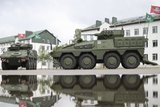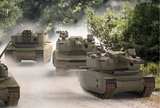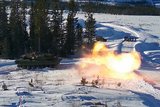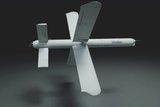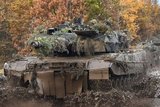DSEi 2011: BAE Systems launches 'invisibility cloak'
BAE Systems has launched a new product that allows a vehicle to match its surroundings in the infrared (IR) spectrum.
At the DSEi exhibition in London on 13 September, company officials demonstrated the technology, which was fitted to the side of a BAE Systems CV90 armoured vehicle and consists of sheets of hexagonal 'pixels' that can rapidly change temperature.
Dubbed Adaptiv, the system employs on-board cameras to detect the background and display the corresponding IR image on the vehicle to help it ‘blend' into the surroundings.
BAE Systems director of marketing communications for Global Combat Systems Vehicles, Hakan Karisson, told reporters that the technology, which was developed in Sweden in conjunction with the Swedish Defence Materiel Administration (FMV), could alternatively be used to mimic another vehicle, to display identification marks for IFF purposes or even to communicate messages to other friendly units.
‘Mainly this is a way of increasing survivability because if he cannot see you, he cannot fire at you. At the end of the 1990s we recognised in Sweden that with the large increase of sensors on the battlefield it was really going to affect how we protected ourselves,' Karisson said.
In development for some four years, the technology uses around 1500 electronically-powered tiles per vehicle that are controlled by an on-board processor that in turn is connected to the platform's IR camera. The tiles are individually heated and cooled using commercially available semi-conducting technology.
Trials in mid-July showed that one side of a CV90 could be made effectively invisible or appear to be other objects, including a 4x4 vehicle, when viewed in the IR spectrum.
‘If you were scanning with surveillance equipment it is definitely harder, if not impossible, to find the vehicle as it is effectively blending in with the mixed pattern in the background,' Karisson explained.
While the company first looked at the viability of using temperature-controlled water for the same ends, it has since found the solid-state system was more efficient and robust.
The system has been designed to be modular and easy to install - a promotional video shown by the company featured the pixels fitted to a helicopter and surface ship.
Peder Sjolund, technologies lead for the project, said the tiles could be replaced individually and the on-board computer would detect the change and incorporate the new tile into the pattern.
‘If you need to blend exactly into the background you need to know exactly the angle the enemy is coming from. But for asymmetric warfare, you can choose from a pre-determined library of patterns that will fit the environment that you are working in,' Sjolund said.
The company believes it is about two years away from moving Adaptiv into production.
More from Land Warfare
-
![Hungary set to begin using Hero 400 loitering munitions]()
Hungary set to begin using Hero 400 loitering munitions
Developed by Israel's Uvision and with systems being sold in the thousands to multiple European NATO countries and the US, the Hero family of loitering systems is also in production in the US and Italy, the latter through Rheinmetall.
-
![Croatia orders Leopards and CAESAR howitzers as Lithuania orders more CAESARs]()
Croatia orders Leopards and CAESAR howitzers as Lithuania orders more CAESARs
The Leopard is becoming the tank of choice in central and eastern Europe as Croatia joins Lithuania, the Czech Republic and Hungary in ordering the platform. Lithuania and Croatia have also signed for CAESAR howitzers.
-
![Light Reconnaissance Strike – enabling a vital mission set (Studio)]()
Light Reconnaissance Strike – enabling a vital mission set (Studio)
A new system-of-systems concept will unlock digital integration of sensors and weapons for Light Forces, allowing them to shape the battlefield environment on their own terms and upgrade legacy platforms.










